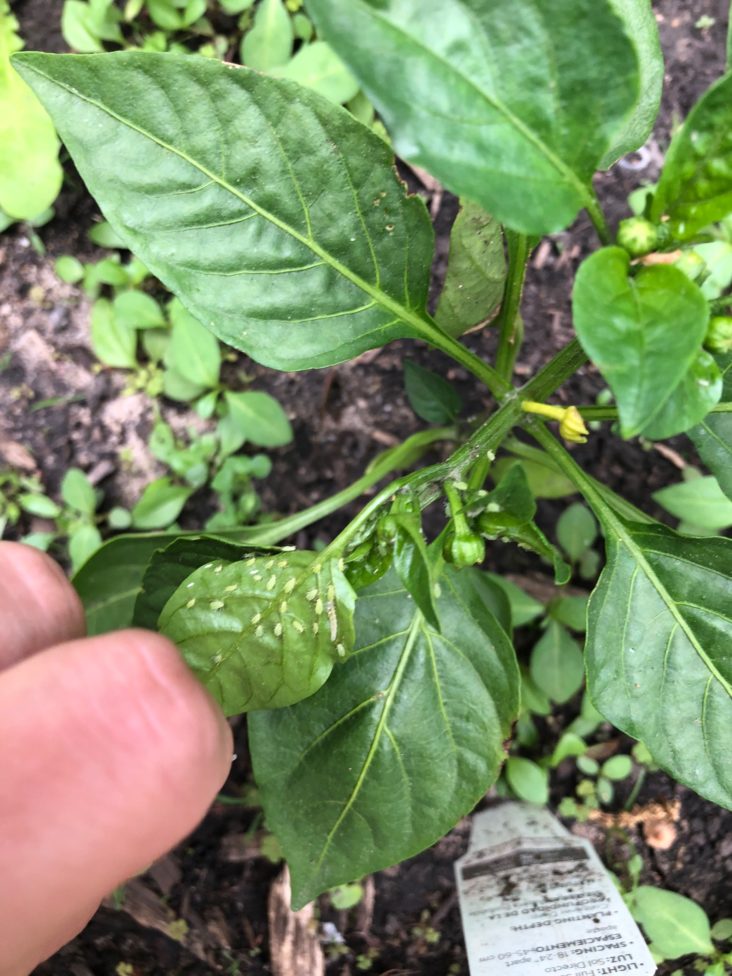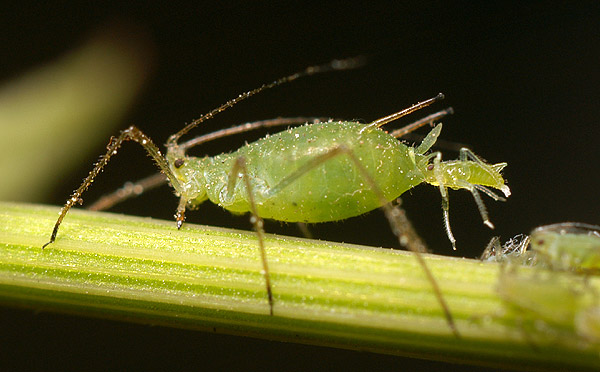Aphids are one of the most common garden pests, both indoors and out, and have ruined many a crop. They breed quickly, and if not dealt with can swiftly grow in number and ruin an entire garden. Luckily, dealing with them is usually quite simple, and if caught early can be done without damage to your plants. In this article, we’ll look at how you can spot and identify aphids on your plants, and then how to deal with them using natural pest control techniques.
What Are Aphids
Aphids are small bugs, usually about ¼ of an inch, and can come in a variety of colors. They’re most commonly described as a light green, but can be anything from black, to white, to even pink.
Aphids typically have pear shaped bodies, and two long antennae. In most cases, aphids thrive in larger groups, so it’s rare to see them alone or in smaller numbers. Where there’s one there’s usually more.
While they typically are wingless, certain varieties will develop small wings in response to lack of food. This helps them move from plant to plant, and can mean your garden quickly becomes overwhelmed.
How To Identify Aphid Damage
Aphids feed by sucking the moisture and nutrients out of plant stems and leaves. They can be found on almost any type of plant, although they tend to favor younger growth or areas of the plant that are already weak.
Be on the lookout for the following signs of Aphid activity:
Check Under The Leaves
First off, having a visual sighting of the pest is the most surefire way to confirm that you have a pest problem. A tip here is to check the undersides of your plant’s leaves as this is an area that aphids like to hide. They can be difficult to see, so check carefully.
It’s rare to see them on the topsides of leaves, so it’s easy to miss them unless you’re actively checking. We recommend giving your plants a quick spotcheck every day or so to help catch aphids, and other pests, early.
Here’s a good picture of some aphids I found in my garden on the underside of a habanero plant.

Misshapen Or Yellowed Leaves
The next most common sign is misshapen leaves, yellowing leaves, or a general unhealthiness of your plant. As the aphids feed, they take key nutrients from your plants which can lead to growth problems.
As mentioned above, be sure to check the undersides of your leaves for damage. This is often where the first signs of stress will be visible.
Damage To Fruits Or Vegetables
Much like your plant’s leaves, aphids will often feed on the fruit, flowers, or vegetables that grow from your plants. Look for signs of damage and be sure to check the undersides or areas that are slightly hidden.
Watch For Sticky Honeydew
As the aphids feed they produce a sticky substance called honeydew. This is a sugary mixture that feels sticky, you can often see or feel it on your plants. What’s more, this can attract additional pests like ants, so it’s important to take care of them as soon as you notice it.
How To Get Rid Of Aphids Naturally
If you determine that you have an aphid problem it’s important to deal with it as soon as possible. Depending on the size of your aphid problem you have several natural options to dealing with them.
Remove The Aphids With Water
For small infestations, using a stream of water is often enough to dislodge the pests. Use a stream hard enough to knock loose the aphids, but not too hard as to damage the plant.
With any luck, the bugs will be removed from the plant and won’t return. This doesn’t always work, but it’s easy enough to start with so it is a good first option.
Use Soapy Water Spray
The next best step is to use a solution of soapy water to remove the pests. Take a spray bottle of water, and add a few drops of dish soap to create a soapy mixture.
Spray this onto the affected areas of the plant, and wait a day to see if there is still an issue. You can repeat this a couple of times and should notice improvements each time.
Note, that it’s often a good idea to test this on a small section of the plant first. This is just to ensure that there are no ill effects from the soap as it has been known to cause issues in a small number of plants.
Neem Oil
Neem oil is another great option that can be used even for large infestations. Neem oil is a natural pesticide that can deal with a large variety of pests without harming your plants. Unlike many chemical pesticides, neem oil is safe for use on edible crops.
Make sure to follow the directions on the packaging as neem oil often needs to come in contact with the pests to be effective.
Removing Affected Areas
As a last resort option, you can simply prune back the infested parts of the plant. This is often done after all other options have been exhausted as, depending on the size of the infestation, can mean a total loss of the plant. That’s often better though than having the pests spread to the rest of your garden.
Aphid Prevention
When it comes to pest control a good defense is often the best offense. Keeping the pests from gaining a foothold is usually far easier than trying to deal with them once they’ve taken hold. In this section, we’ll look at a few easy ways to hopefully deter aphids from ever seeing your plants as a food source.
Check and Prune Frequently
The single most important thing to do to keep pests away is to frequently check your plants. This helps you catch problems before they begin, and is far easier than dealing with an existing problem. If you notice any signs of pests take action right away.
You should also be actively pruning and cleaning up dead or dying parts of your plants. These are often the easiest areas for pests to start as the plant is already weakened. By keeping your plants healthy you make it that much harder for an infestation to take hold. Keeping your plants healthy is important to prevent pests as unhealthy plants are easier for pests to live on.
Grow Plants Aphids Hate
While aphids are found on a huge variety of plants, there are a number that actively repel them. Growing these plants can help keep aphids away from your other, more appetizing plants.
Some of these aphid repellers includes:
- Catnip
- Garlic
- Chives
Planting crops in close proximity for beneficial purposes is known as companion gardening. We have an entire article on companion gardening, so check it out if you want to learn more.
Keep Beneficial Insects
Insects like ladybugs are natural predators of aphids yet don’t cause any harm to your garden. Releasing these into your garden is a good way to keep certain pests away, or deal with small, existing infestations. As an added bonus, aphids are not the only pest that lady bugs will keep away so you get protection from some other common pest varieties.
Pest Proofing Your Garden
Finding pests in your garden can be scary, but with the right knowledge it doesn’t have to be the end. Using the techniques above, you’ll be able to identify, remove, and prevent aphids from taking hold in your garden.
Aphids FAQ
Can You Get Aphids in an Indoor Garden?
While it’s rare, you can still get aphids, or any pest, in an indoor garden. This is most common for plants left outside or on a balcony, but any plant can be susceptible to aphids.
What Are The Signs of Aphids?
Aphids feed on the leaves and stems of your plant, so will lead to weak or sickly looking plants. You may also notice a sticky substance called honeydew which is a secretion of the aphid.
How Do You Get Rid Of Aphids?
Using soapy water or neem oil are generally natural and easy ways to deal with aphids, along with a variety of other pests in your garden.
How Long Do Aphids Live For?
Aphids live for about a month, but reach maturity in about a week. This means that aphids can reproduce quite a lot despite their short lifespan.
Do Aphids Live In Soil?
In most cases aphids will live on the undersides of leaves, but certain varieties, like the gray-white root aphid, can live in soil and actually attack the roots of your plants.







